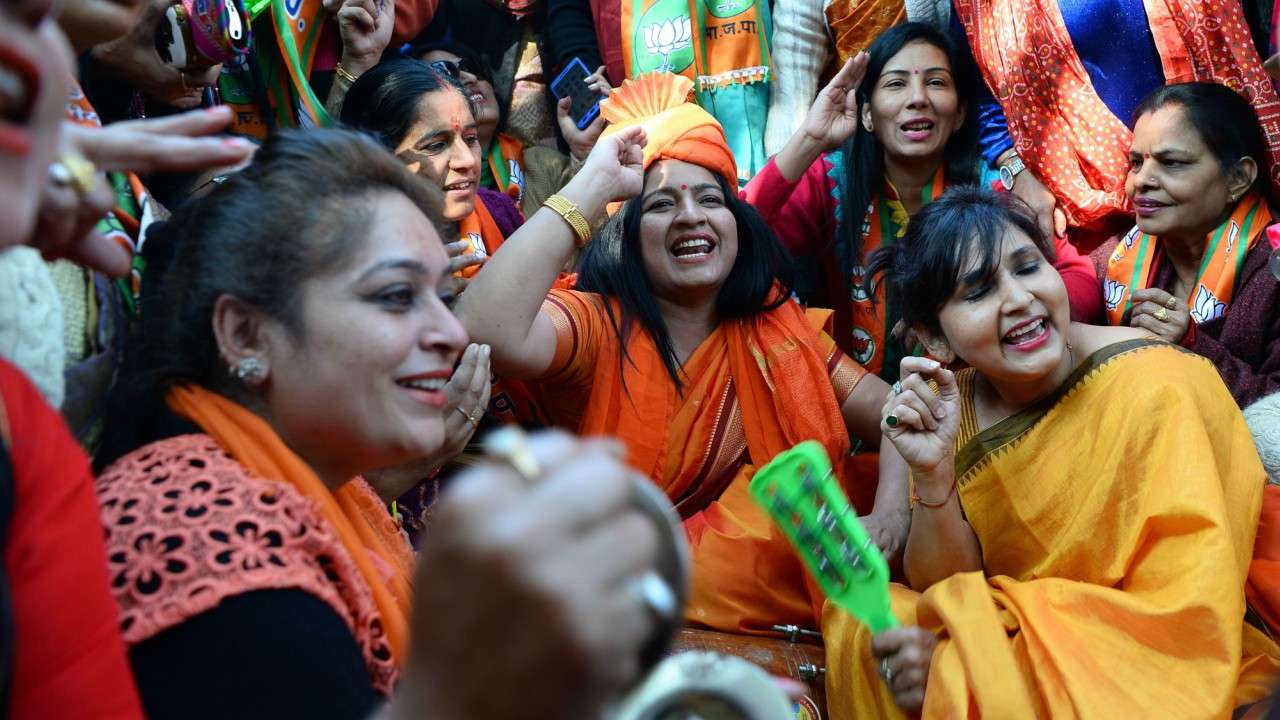
As predicted by exit polls, it’s a saffron sweep again, with BJP retaining Gujarat and wresting Himachal from Congress. Sure it had a bit of a shock, when Congress pulled away once and both its CM and deputy CM trailing at one point, but as they say the party with superior organisation and the better leader finally prevailed. As trends indicate, BJP will end up just short of 100, less than what it got in 2012 and much short of Amit Shah’s 150 seats target prediction. But after 22 years of anti-incumbency and battling resentment from Patidars , one suspects the saffron party will be more or less happy with this electoral win.
Here are the major factors that lead to BJP’s win in Gujarat.
The NaMo factor:
It may not be tsu-Namo any longer, but it’s sufficient to get BJP across the line. PM Modi did close to 40 rallies in Gujarat, criss-crossing his home state where his party was stuck on a rut. But what showed his great leadership quality truly was the ability to understand that people are veering away from BJP during the closing stages of the election. Thus came the changed narrative in the last phase of the polls bringing the Pakistan conspiracy theory and fully using the Mani Shankar Aiyar gaffe. He managed to be proactive and got Congress in the defensive. Naysayers will call it cynical politics not proper for the PM of world’s largest democracy, but he got the job done for his party, and that’s what all matters in electoral politics.
BJP’s urban fortress remains intact:
Struggling with triple whammy of demonetization, GST and Patidar agitation, many thought BJP would fare poorly in its urban centres. As it turns out, the voters may be unhappy with BJP, but the love affair continues.
A cursory look at Gujarat map shows giant cluster of saffron surrounding all the major cities. It is leading in 13 out of 16 in Surat and 17 out of 21 in Ahmedabad. BJP is down 6% from 2012 in vote share in urban seats, but Congress still lags behind. BJP has won 43 out of the 55 urban constituencies. In many places vote percentage has fallen sharply from 2012 and 2014. It’s plausible to guess that BJP supporters who are unhappy with the party but don’t want to reward the Congress, stayed away and saved Modi’s team from blushes.
Hardik factor worked but only just..:
The Patel factor reigned supreme in Saurashtra and North Gujarat, where the agitation started originally. In Saurashtra, BJP is set to lose around 13 seats. It is ahead only in 22, whereas it won 35 in 2012. However, in North Gujarat, the party has done decently well just dropping 2-3 seats from 2012. It has done reasonably well even in districts like Mehsana, Patan, Banaskantha. For Congress to win, Hardik’s clout needed to carry crucial seats in these district. But somehow the saffron party managed to hold on to many of the bellweather seats, thanks to older Patels voting for BJP and Hardik, who is a Kadwa Patel not getting support from Leuva Patels. Infact of the total 25 Patel dominated seats, BJP and Congress won 12 each. The state government’s good performance during the floods managed to give them brownie points in districts like Banaskantha. The party has lost only three seats in Central Gujarat, which has been a major Congress bastion.
Congress couldn’t reap full dividends from agrarian distress:
With crops failing for two successive times, and poor MSP for cotton and groundnuts, many pundits expected the Congress to virtually sweep the rural seats. In the rural centres, in 2012, Congress was only a percentage point behind BJP in vote share. So the grand old party really had the chance to surge ahead in rural Gujarat, where the famed Gujarat model hasn’t really reached. However, the party couldn’t exactly latch on to the loose balls given by BJP and out of the 128 rural or semi-rural seats, it won 71 out of them, good but not good enough. In short, Congress needed to sweep rural Gujarat to fill the deficit of their weakness in urban pockets. But it failed in that account.
Congress couldn’t decode the caste calculus:
Congress before the elections had assurance of support from two of the largest caste groups, the Thakors and Patils. This along with Jignesh Mevani bringing the dalit vote should have been game-set-match for Congress. But on ground, owing to presence of rebels, poor selection of candidates and lack of proper coordination between PAAS and Congress workers, the caste advantage couldn’t be leveraged. While Mevani and Thakor both pulled through, they have some way to go before becoming cult leaders like Lalu or Mulayam, who can get the support of their entire caste group enmasse. But for Congress, the most disappointing thing would be loss of their several tall leaders. The likes of Arjun Modhwadia, Shaktisinh Gohil, Indranil Rajguru means the party is bereft of credible leaders who can tap on to popular resentment against ruling government. The Congress wanted to win this election by outsourcing it to caste leaders from outside. The gamble worked partially but failed in its core purpose, thus giving Rahul Gandhi many things to ponder upon.
In the end, it was a case of a missed opportunity for Congress. It can pat on its back for winning more seats and giving BJP a real scare, but considering the anti-incumbency of 22 years , an ineffective state leadership of the saffron party and massive resentment till recently among the Patels, the Congress should and could have won easily. But BJP’s superior ground game and the Modi factor, finally got BJP home. Modi like in many of the past elections is truly the man of the match. When the dust settles, Rahul and rest will be just sideshows of the 2017 Gujarat election history.